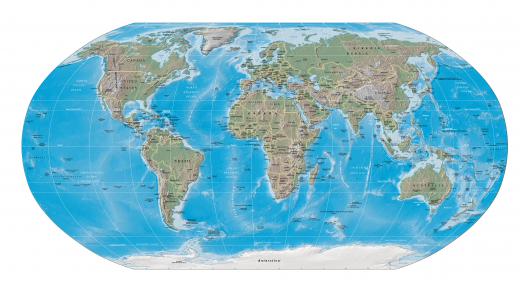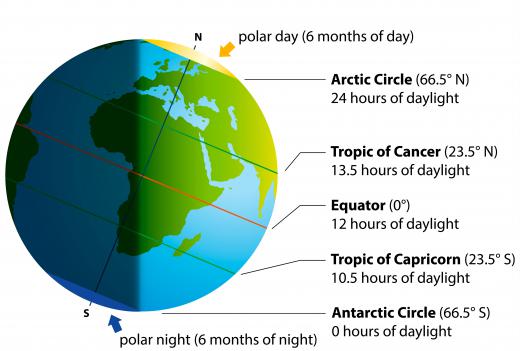What is a Graticule?
 Mary McMahon
Mary McMahon
A graticule is a network of lines which can be used for geographic plotting, scale, and focusing, depending on the application. While sometimes described as a grid, a graticule is not necessarily a grid, and there are several different ways to describe coordinates within the graticule. A common example of a graticule is a grid of lines on a map which corresponds to longitude and latitude.
A geographic graticule is a network of geographic lines. People locate objects within the network of intercrossing lines by looking specifically at their geographic locations. Rather than giving locations in terms of the grid, such as with the use of numbers along the X and Y axis, people talk about their latitude and longitude. A geographic graticule may use curved lines for longitude to more accurately depict locations within the network of lines, since the globe is round and the graticule is flat, requiring some adjustments in the interest of accuracy.

Graticules can also be attached to eyepieces. An eyepiece graticule can be used to superimpose a grid on whatever someone is viewing through the eyepiece, whether it's a colony of microscopic organisms on a petri dish, or the natural environment as viewed through a spotting scope. The lines of the grid can be used to provide a sense of scale, as for example when people want to measure objects in their view, and also for navigational assistance, allowing people to isolate objects within specific squares.

Having a grid of crossed lines can be very helpful for some types of optical focusing. It can also be beneficial when people are aiming, and when people want to provide absolute information about what they are viewing. Rather than saying “look to the upper left of the image,” with a graticule, someone can say “check square F2.” Graticules can also be used for measurement and accurate population counts; it is easier to count the contents of each square and add them up than it is to try and count everything in the image at once.
Different graticules are designed for different purposes. An eyepiece graticule may be designed to provide information about scale, or to act as a simple grid for the purpose of isolating objects within the grid. Map graticules are carefully calibrated so that they correspond as closely as possible to latitude and longitude in the real world. Even with adjustment, at high latitudes, it can be difficult to be accurate.
AS FEATURED ON:
AS FEATURED ON:












Discussion Comments
@MissCourt - A perfect game example of graticule grids is Dungeons and Dragons. Every map is designed on a grid so that you can move your character around and judge distances for spells and attacks. Since most computer and video games are based off of Dungeons and Dragons, of course they would want to use a grid system. You can take a Dungeons and Dragons map and enter it directing into the computer just by numbering the grid boxes.
You forgot to mention it, but the military also uses their graticules to measure the size of targets and landscapes. Just like a game boss takes up four squares, a target might take up multiple squares.
@MissCourt - Thank you for the clear example -- I never thought about how grids were used in game design. I guess it makes sense. I remember the old (I mean very old) RPGs used a dungeon map that literally was a grid. You would see your location at the top of the screen like “Basement 1” and stuff like that. Then you could look at the map and see where you came from.
I think it was "Quest for Glory 1" that I played all of the time. There wasn't a built-in map, but it was easy to sit and chart your course through the mazes on graph paper.
@amsden2000 - The military uses graticules just that reason. It's easier to find the enemy and your location when the land is split up. For instance they can order a strike on a particular square and everyone can find it easier.
Military graticules have lots of features built in to enhance their effectiveness. In particular, they can accurately calculate the distance that is seen through the eyepiece graticule -- which is great for helping with aim. If you are on a battlefield and are tired, graticules can help you get a proper estimate of what you're looking at without you having to calculate yourself.
An odd comparison is with old video games. Most video games broke the game up into screens, or graticule grids, that could then be arranged to form the world. Classic text-based multi-user dungeons (MUDs) used a graticule-like system all the time -- naming each map part "A1," "A2" and so on.
I design fantasy maps as a hobby and I always makes sure to include a accurate graticule. Almost any good map of the anything has a graticule built in. It just makes sense to break areas up into manageable pieces.
As the article said, it's much easier to tell someone where to look if everything has a number and letter assigned to it. Imagine if you were lost? It would be much easier to find out where you are if you could narrow your location down to any square that had a type of landmark it in.
Post your comments